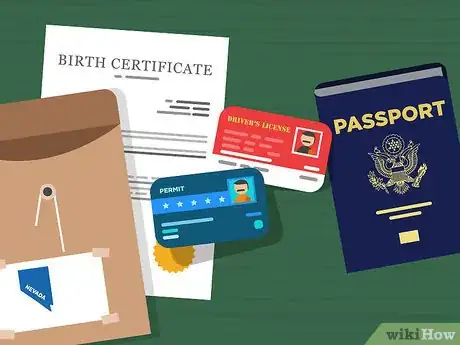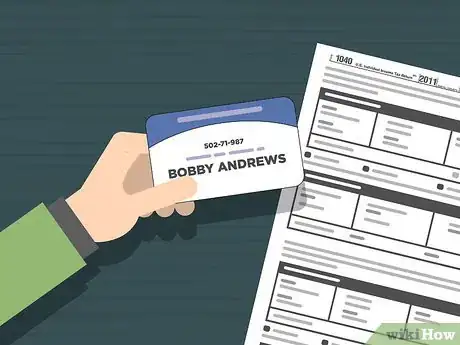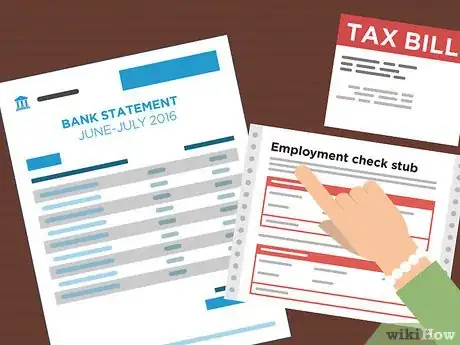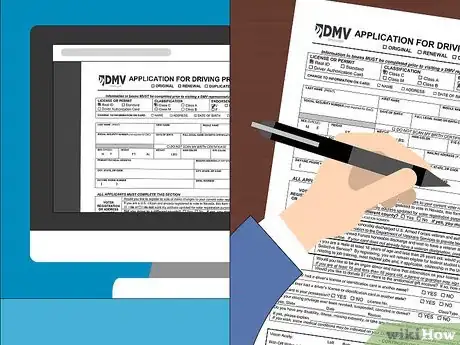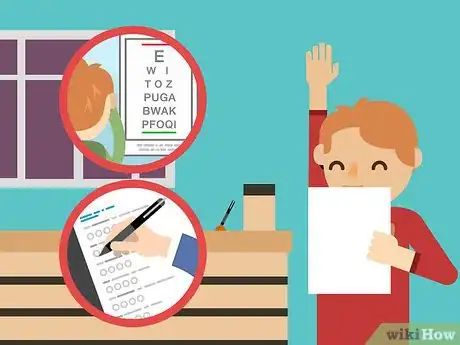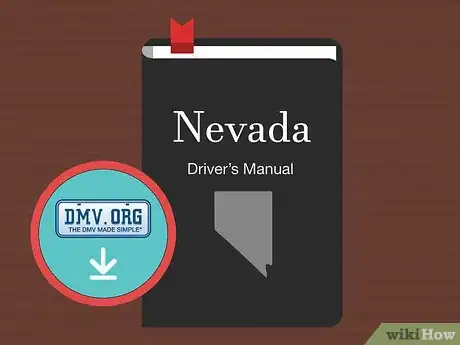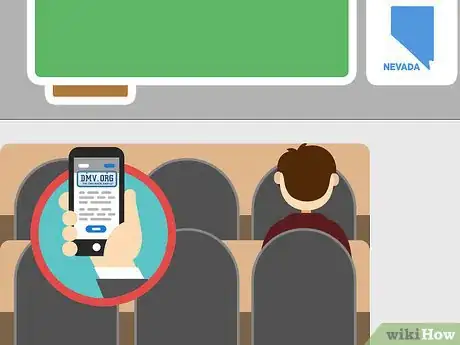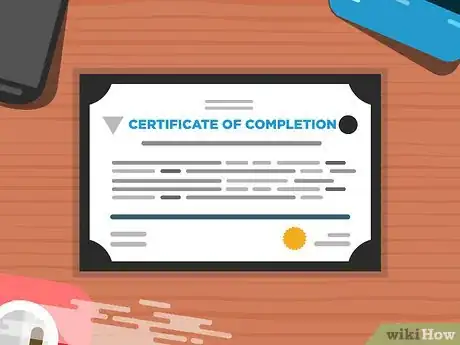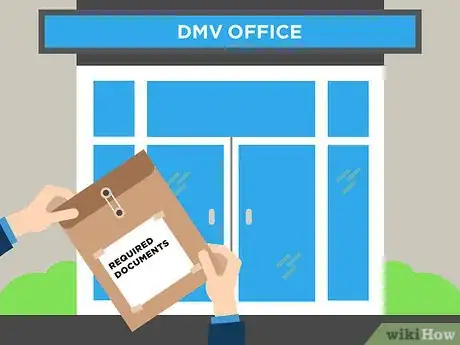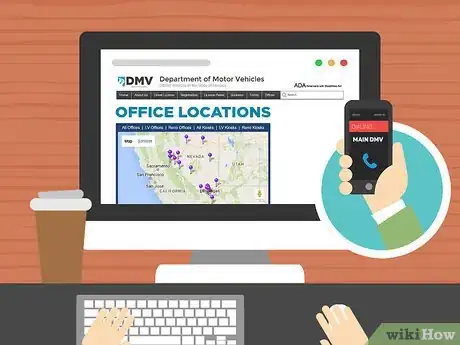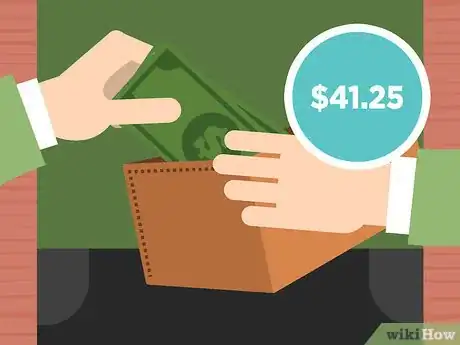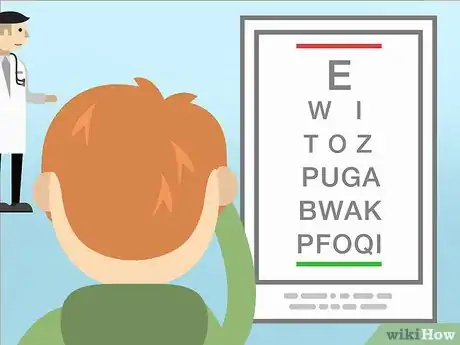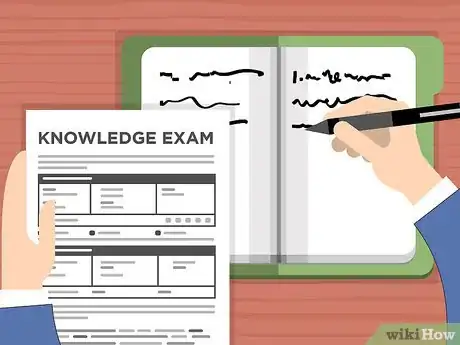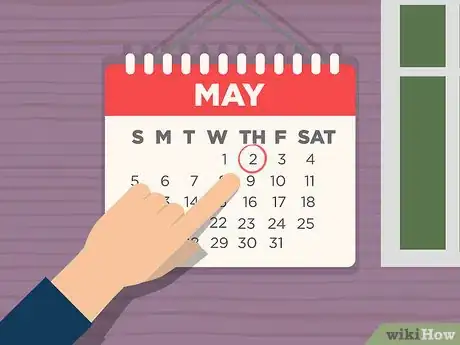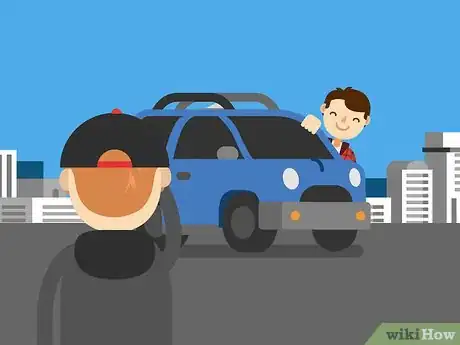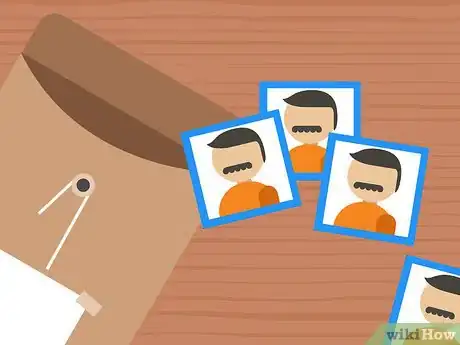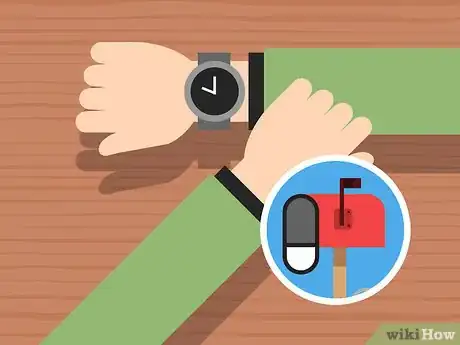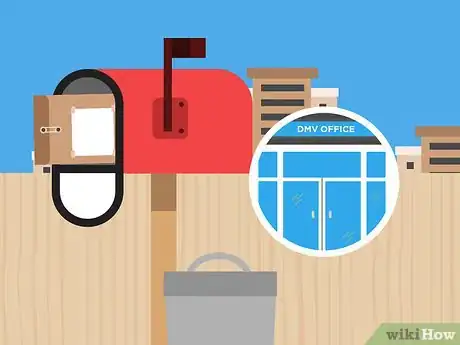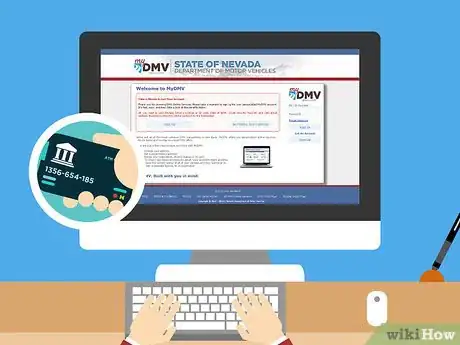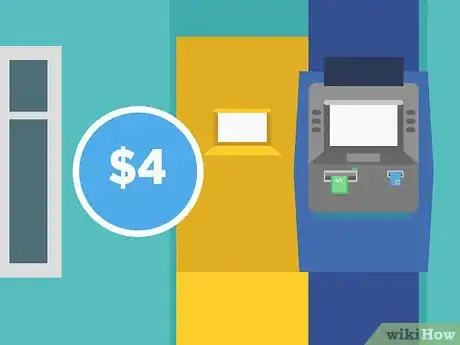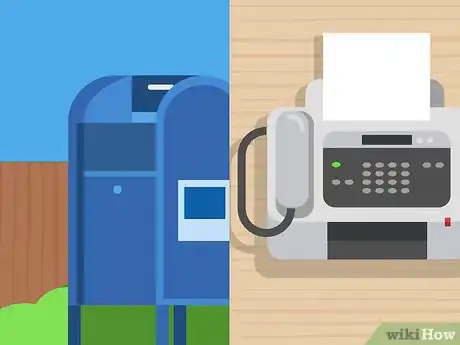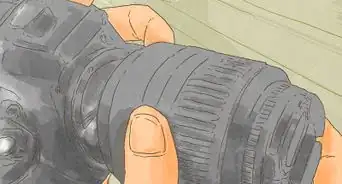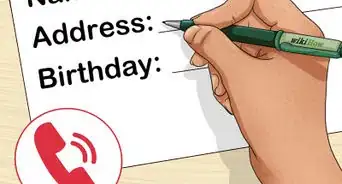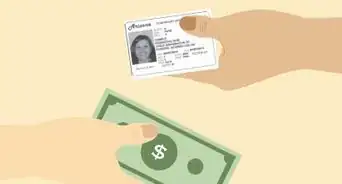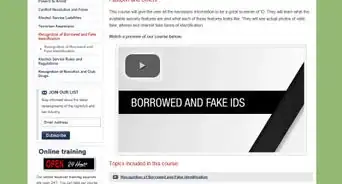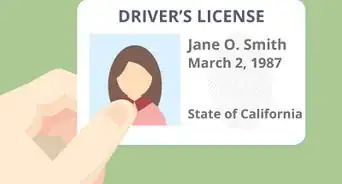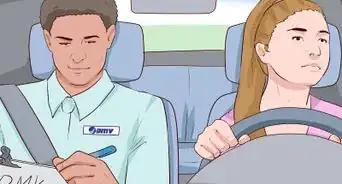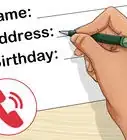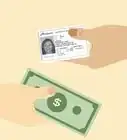This article was co-authored by Clinton M. Sandvick, JD, PhD. Clinton M. Sandvick worked as a civil litigator in California for over 7 years. He received his JD from the University of Wisconsin-Madison in 1998 and his PhD in American History from the University of Oregon in 2013.
There are 11 references cited in this article, which can be found at the bottom of the page.
This article has been viewed 65,833 times.
To get a driver's license in Nevada, you first establish yourself as a resident of Nevada and complete a driver's license application. If you are a new driver, you must take and pass the vision, knowledge, and driving skills tests. If you already have an out-of-state driver's license and are moving to Nevada as a new resident, you will be required to turn in your current driver's license in exchange for a Nevada license.
Steps
Gathering Necessary Documents
-
1Provide proof of identity. First-time applicants need to establish their identity. If you have changed your name, then you will need proof of the name change, such as a marriage certificate, divorce decree, or court order. Acceptable documents to establish identity include:[1]
- State-issued birth certificate (the original or a certified copy)
- A valid, unexpired United States Passport or United States Passport Card
- Consular Report of Birth Abroad
- An out-of-state driver's license, instruction permit, or identification card that contains a Real ID marking approved by the Department of Homeland Security
-
2Provide a document which includes a Social Security Number. Examples of documentation include your Social Security Card, a federal income tax return, or an employment pay stub.[2]Advertisement
-
3Bring proof of Nevada residence. Because Nevada does not issue driver's licenses to visitors, you need to establish that you are a resident of Nevada.[3] You must provide 2 of the following documents:[4]
- A current lease on which the applicant appears as a lessee
- Public utility record from the last 60 days
- Bank or credit card statement from the last 60 days
- Employment check stub from the last 60 days
- Most recent tax records or record of assessed or paid property taxes
- Documentation of a current mortgage
- Other documents listed on the DMV website
-
4Complete an application. The application is here. You may download it and print it off or complete the application in PDF form by typing in the blue boxes. You will be asked for the following:
- Name
- Social Security Number
- Place of Birth
- Address of your primary physical residence and your telephone number
- Mother's maiden name
- Height, weight, hair color and eye color
- Questions about your driving record in other states, including whether you have ever had your driving privileges revoked
Passing a Driver's Education Course
-
1Get a permit. A driver at least 15 ½ may obtain a permit by presenting proof of identity and passing vision and knowledge tests.
- A parent or guardian must sign a statement accepting proof of financial responsibility.
-
2Study the Nevada driver's manual. A driver's manual can be obtained from any DMV office location or can be downloaded from the DMV website.
- Visit the DMV website and click on the "Forms" link at the top of your session to find and download a copy of the driver's manual.
-
3Attend a driver's education course. The course is a total of 30 classroom hours and will require you to complete at least 50 hours of on-hands driving experience, 10 of which must be in darkness.[5]
- Enroll for a driver's education course at a public or private high school, or enroll for a course at a DMV-licensed professional driving school.
- To access a list of professional driving schools, visit the DMV website and click on "Professional" under the Driving Schools category. You may also call the main DMV office at 775-684-4830.
-
4Obtain your Certificate of Completion. The Certificate of Completion is given to you after you have completed the driver's education course. You must bring this document to the DMV with the other required documents.
-
5Bring the required documents and fees to a full-service Nevada DMV location. You must complete vision and knowledge tests to receive an instruction permit, which you will use until after you have passed the driving skills test.
- If you are under 18 years old and are applying for an instruction permit, you must also obtain a "Beginning Driver Experience Log" from the DMV, which you will be required to fill out each time you drive.[6]
Getting the License
-
1
-
2
-
3Take the vision test. Your vision must be 20 over 40 or better to gain full driving privileges; otherwise, you may be denied a license or have driving restrictions.
- You may wear your glasses during the exam. However, if you need to use glasses or contact lenses to pass the exam, a notation will be made on your license.[10]
- If you are 21 or older and currently licensed as a driver, then you only need to take the vision test. No knowledge test or skills test is required.[11]
- If you are under 21, then you will need to take the vision and knowledge test but not the skills test.[12]
-
4
-
5Schedule an appointment to take the driving skills test. You can schedule an appointment online or over the telephone. You cannot earn a driver's license as a first-time driver until you have passed the skills test.
- Visit the DMV website featured in the Sources section of this article and click on the link for "Online Drive Test Scheduling" to make your appointment.
- If you prefer to schedule an appointment over the telephone, call the appropriate number for your area. Las Vegas residents can call 702-486-4368 and select option 3; residents from Reno, Sparks, or Carson City should call 775-684-4368 and select option 6; and residents that live in all other parts of Nevada can call 1-877-368-7828 and select option 6.
-
6Attend your skills test appointment. An examiner will be inspecting the car for safety and will check its insurance and registration. The driving test itself will vary depending on instructor, but you should plan on the test covering the following:
- Finding and using the car's controls: accelerator, signals, brake, horn, etc.
- Releasing the brake
- Checking over your shoulder that the way is clear
- Using turn signals properly
- Properly stopping the vehicle and backing it up
- Parking on a hill
- Ability to obey traffic signs
- Ability to follow the speed limit and obey lane markings
- Your overall safety, including your awareness of traffic around you
-
7Have your picture taken. You will need to sit and have your picture taken in order to get a license. Your photo must appear on the license itself.
-
8Wait to receive your driver's license in the mail after completing the skills test. Your driver's license will be mailed to you within 10 business days.
- If you are under 16 years of age, you will receive an instruction permit until you become 16 years old. At that time, you can then apply for a full driver's license.
- If you want to receive an interim document that gives you full driving privileges before you receive your driver's license in the mail, you must pay an additional $3 fee.
Renewing Your License
-
1Renew in person. If you receive a postcard informing you to renew in person, then you can't renew using any other renewal method.[15] You may also renew early, if you choose.
- If you are upgrading to a Real ID driver's license, then you must bring proof of identity as well as proof of residency.
- A Real ID license will soon be required for boarding aircraft and for accessing federal buildings.[16]
-
2Use the internet to renew. If your renewal notice has an access code, then you can renew online. You can do so by visiting this web portal. You have the option of creating an account, although you do not need to.
- To get started, enter your driver's license number and your renewal code in the applicable fields.
- You may pay by using a major credit card or by using eCheque.
- The online services are unavailable for two hours each night (midnight to 2 a.m.)
-
3Renew using a kiosk. You may also renew using a kiosk, provided your renewal notice does not request that you renew in person. You can find a kiosk by visiting this website.
-
4Renew by mail or fax. You should only use this option if you cannot renew by internet or through a kiosk. You can use it, for example, if you are a Nevada resident who is temporarily out of state.[20] You will need to download the application.
- You may not renew by mail/fax two times in a row, unless you are a member of the military or the dependent of a member.[21]
- You must visit a physician, optician, optometrist, or driver's license issuing agency in your area and take a vision test. The person administering the test must report your vision and sign the form.[22]
- If you who will turn 71 before the expiration of your license, you must also have a physical and obtain a signature from the physician attesting to whether you have a medical condition that would prevent or impair your ability to drive.[23] The physical must occur within 90 days of the submission of the application.
- You should probably include a payment authorization slip.
References
- ↑ http://www.dmvnv.com/dlresidency.htm
- ↑ http://www.dmvnv.com/dlresidency.htm
- ↑ http://www.dmvnv.com/newresident.htm
- ↑ http://www.dmvnv.com/dlresidency.htm
- ↑ http://www.dmvnv.com/pdfforms/dld130.pdf
- ↑ http://www.dmvnv.com/pdfforms/dld130.pdf
- ↑ http://www.dmvnv.com/locat.htm
- ↑ http://www.dmvnv.com/dlfees.htm
- ↑ http://www.dmvnv.com/dlfees.htm
- ↑ http://www.dmvnv.com/dltesting.htm
- ↑ http://www.dmvnv.com/dltesting.htm
- ↑ http://www.dmvnv.com/dltesting.htm
- ↑ http://www.dmvnv.com/dltesting.htm
- ↑ http://www.dmvnv.com/dltesting.htm
- ↑ http://www.dmvnv.com/dlrenewal.htm
- ↑ http://www.dmvnv.com/dlrenewal.htm
- ↑ http://www.dmvnv.com/dlrenewal.htm
- ↑ http://www.dmvnv.com/kiosk.htm
- ↑ http://www.dmvnv.com/kiosk.htm#realid
- ↑ http://www.dmvnv.com/pdfforms/dmv204.pdf
- ↑ http://www.dmvnv.com/pdfforms/dmv204.pdf
- ↑ http://www.dmvnv.com/pdfforms/dmv204.pdf
- ↑ http://www.dmvnv.com/pdfforms/dmv204.pdf
